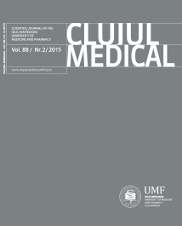Combined glutathione S transferase M1/T1 null genotypes is associated with type 2 Diabetes mellitus
DOI:
https://doi.org/10.15386/cjmed-436Keywords:
GSTT1, GSTM1 null alleles, diabetes mellitus type type 2, Romanian populationAbstract
Background
Due to new genetic insights, a considerably large number of genes and polymorphic gene variants are screened and linked with the complex pathogenesis of type 2 diabetes (DM).
Our study aimed to investigate the association between the two isoforms of the glutathione S-transferase genes (Glutathione S transferase isoemzyme type M1- GSTM1 and Glutathione S transferase isoemzyme type T1-GSTT1) and the prelevance of DM in the Northern Romanian population.
Methods
We conducted a cross-sectional, randomized, case-control study evaluating the frequency of GSTM1 and GSTT1 null alleles in patients diagnosed with DM. A total of 106 patients diagnosed with DM and 124 healthy controls were included in the study. GSTM1 and GSTT1 null alleles genotyping was carried out using Multiplex PCR amplification of relevant gene fragments, followed by gel electrophoresis analysis of the resulting amplicons.
Results
Molecular analysis did not reveal an increased frequency of the null GSTM1, and GSTT1 alleles (mutant genotypes) respectively in the DM group compared to controls (p=0.171, OR=1.444 CI=0.852-2.447; p=0.647, OR=0.854, CI=0.436-1.673). Nevertheless, the combined GSTM1/GSTT1 null genotypes were statistically significantly higher in DM patients compared to control subjects (p=0.0021, OR=0.313, CI=0.149-0.655)
Conclusions
The main finding of our study is that the combined, double GSTM1/GSTT1 null genotypes are to be considered among the polymorphic genetic risk factors for type 2 DM.
References
Glamočlija U., Jevrić-Čaušević A., Genetic polymorphisms in diabetes: Influence on therapy with oral antidiabetics, Acta Pharmaceutica. 2010;60(4):387–406
www.who.int
http://www.idf.org/membership/eur/romania
Gallou G, Ruelland A, Legras B, Maugendre D, Allannic H, Cloarec L. Plasma malondialdehyde in type 1 and type 2 diabetic patients. Clin Chim Acta 1993;28(214):227–34
Baynes JW, Thorpe SR. Role of oxidative stress in diabetic complications: a new perspective on an old paradigm. Diabetes 1999;48:1–9.
Oakley A. Glutathione transferases: a structural perspective. Drug Metab Rev 2011;43:138–51
Wilce MC, Parker MW. Structure and function of glutathione Stransferases. Biochim Biophys Acta 1994;1205:1–18.
Pemble S, Schroeder KR, Spencer SR, Meyer DJ, Hallier E, Bolt HM, et al. Human glutathione S-transferase theta (GSTT1): cDNA cloning and the characterization of a genetic polymorphism. Biochem J 1994;300:271–6.
Seidegard J, Vorachek WR, Pero RW, Pearson WR. Hereditary differences in the expression of the human glutathione transferase active on trans-stilbene oxide are due to a gene deletion. Proc Natl Acad Sci USA 1988;85:7293–7.
Go¨nu¨l N, Kadioglu E, Kocabas NA, Ozkaya M, Karakaya AE, Karahalil B. The role of GSTM1, GSTT1, GSTP1, and OGG1 polymorphisms in type 2 diabetes mellitus risk: a case-control study in a Turkish population. Gene 2012;505:121–7.
Bid HK, Konwar R, Saxena M, Chaudhari P, Agrawal CG, Banerjee M, et al. Association of glutathione S-transferase (GSTM1, T1 and P1) gene polymorphisms with type 2 diabetes mellitus in north Indian population. J Postgrad Med 2010;56: 176–81.
Moasser E, Kazemi-Nezhad SR, Saadat M, Azarpira N. Study ofthe association between glutathione S-transferase (GSTM1, GSTT1, GSTP1) polymorphisms with type II diabetes mellitus in southern of Iran. Mol Biol Rep 2012;39:10187–92
Amer MA, Ghattas MH, Abo-Elmatty DM, Abou-El-Ela SH. Influence of glutathione S-transferase polymorphisms on type-2 diabetes mellitus risk. Genet Mol Res 2011;10:3722–30
Wang G, Zhang L, Li Q. Genetic polymorphisms of GSTT1, GSTM1, and NQO1 genes and diabetes mellitus risk in Chinese population. Biochem Biophys Res Commun 2006;341:310–3.
Pinheiro DS, Rocha Filho CR, Mundim CA, Ju´nior Pde M, Ulhoa CJ, Reis AA, et al. Evaluation of glutathione S-transferase (GSTM1 and GSTT1) deletion polymorphisms on type-2 diabetes mellitus risk. PLoS One 2013;8:e76262.
Tang ST, Wang CJ, Tang HQ, Zhang Q, Wang Y. Evaluation of glutathione S-transferase genetic variants affecting type 2 diabetes susceptibility: a meta-analysis. Gene 2013;530:301–8.
Hori M, Oniki K, Ueda K, Goto S, Mihara S, Marubayashi T, et al. Combined glutathione S-transferase T1 and M1 positive genotypes afford protection against type 2 diabetes in Japanese. Pharmacogenomics 2007;8:1307–14.
Ramprasath T, Murugan PS, Prabakaran AD, Gomathi P, Rathinavel A, Selvam GS. Potential risk modifications of GSTT1, GSTM1 and GSTP1 (glutathione S-transferases) variants and their association to CAD in patients with type 2 diabetes. Biochem Biophys Res Commun 2011;47:49–53.
Amer MA, Ghattas MH, Abo-Elmatty DM, Abou-El-Ela SH. Evaluation of glutathione S-transferase P1 genetic variants affecting type-2 diabetes susceptibility and glycemic control. Arch Med Sci 2012;8:631–6.
Bid HK, Konwar R, Saxena M, Chaudhari P, Agrawal CG, Banerjee M, et al. Association of glutathione S-transferase (GSTM1, T1 and P1) gene polymorphisms with type 2 diabetes mellitus in north Indian population. J Postgrad Med 2010;56: 176–81.
Wild S, Roglic G, Green A, Sicree R, et al. (2004). Global prevalence of diabetes: estimates for the year 2000 and projections for 2030. Diabetes Care 27: 1047-1053.
World Health Organization. Noncommunicable Diseases Country Profiles 2011. WHO Global Report. Geneva, Switzerland: WHO, 2011. Accessed on January 05, 2013 at: http: //www.who.int/ nmh/publications/ncd _profiles2011/en/
London SJ, Yuan JM, Chung FL, Gao YT, et al. (2000). Isothiocyanates, glutathione S-transferase M1 and T1 polymorphisms, and lung-cancer risk: a prospective study of men in Shanghai, China. Lancet 356: 724-729.
Elham Moasser, Influence of glutathione S-transferase gene polymorphism on the risk of type 2 diabetes mellitus retinopathy in south Iranian population J Diabetes Metab 2013, 4:6
Pushpank Vats, Honey Chandra, Monisha Banerjee. Glutathione S-transferase and Catalase gene polymorphisms with Type 2 diabetes mellitus. Dis Mol Med. 2013; 1(3): 46-53
Downloads
Additional Files
Published
How to Cite
Issue
Section
License
The authors are required to transfer the copyright of the published paper to the journal. This is done by agreeing to sign the Copyright Assignment Form. Whenever the case, authors are also required to send permissions to reproduce material (such as illustrations) from the copyright holder.

The papers published in the journal are licensed under a Creative Commons Attribution-NonCommercial-NoDerivatives 4.0 International License.

